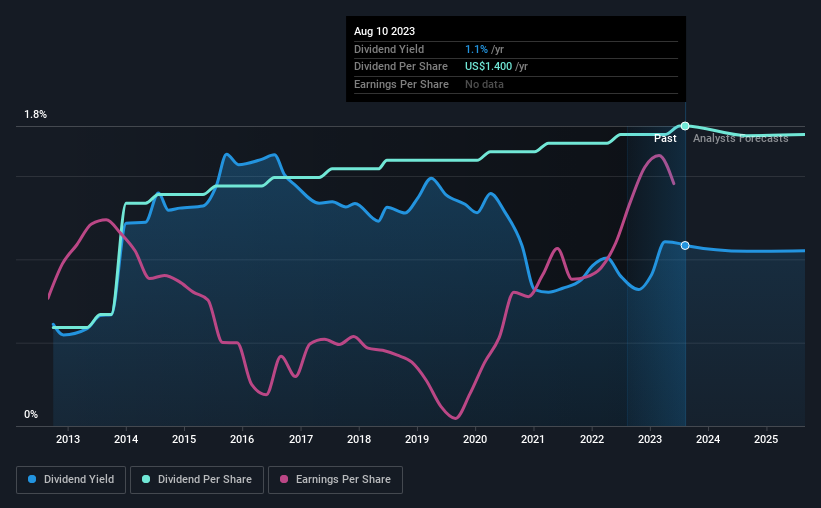Should You Buy Lindsay Corporation (NYSE:LNN) For Its Upcoming Dividend?
Regular readers will know that we love our dividends at Simply Wall St, which is why it's exciting to see Lindsay Corporation (NYSE:LNN) is about to trade ex-dividend in the next 4 days. The ex-dividend date occurs one day before the record date which is the day on which shareholders need to be on the company's books in order to receive a dividend. The ex-dividend date is important as the process of settlement involves two full business days. So if you miss that date, you would not show up on the company's books on the record date. Meaning, you will need to purchase Lindsay's shares before the 16th of August to receive the dividend, which will be paid on the 31st of August.
The company's next dividend payment will be US$0.35 per share, and in the last 12 months, the company paid a total of US$1.40 per share. Based on the last year's worth of payments, Lindsay has a trailing yield of 1.1% on the current stock price of $129.26. Dividends are an important source of income to many shareholders, but the health of the business is crucial to maintaining those dividends. So we need to investigate whether Lindsay can afford its dividend, and if the dividend could grow.
Check out our latest analysis for Lindsay
If a company pays out more in dividends than it earned, then the dividend might become unsustainable - hardly an ideal situation. Lindsay is paying out just 21% of its profit after tax, which is comfortably low and leaves plenty of breathing room in the case of adverse events. A useful secondary check can be to evaluate whether Lindsay generated enough free cash flow to afford its dividend. It paid out 21% of its free cash flow as dividends last year, which is conservatively low.
It's positive to see that Lindsay's dividend is covered by both profits and cash flow, since this is generally a sign that the dividend is sustainable, and a lower payout ratio usually suggests a greater margin of safety before the dividend gets cut.
Click here to see the company's payout ratio, plus analyst estimates of its future dividends.
Have Earnings And Dividends Been Growing?
Companies with consistently growing earnings per share generally make the best dividend stocks, as they usually find it easier to grow dividends per share. If earnings fall far enough, the company could be forced to cut its dividend. It's encouraging to see Lindsay has grown its earnings rapidly, up 24% a year for the past five years. Lindsay looks like a real growth company, with earnings per share growing at a cracking pace and the company reinvesting most of its profits in the business.
The main way most investors will assess a company's dividend prospects is by checking the historical rate of dividend growth. Since the start of our data, 10 years ago, Lindsay has lifted its dividend by approximately 12% a year on average. It's exciting to see that both earnings and dividends per share have grown rapidly over the past few years.
To Sum It Up
Should investors buy Lindsay for the upcoming dividend? We love that Lindsay is growing earnings per share while simultaneously paying out a low percentage of both its earnings and cash flow. These characteristics suggest the company is reinvesting in growing its business, while the conservative payout ratio also implies a reduced risk of the dividend being cut in the future. There's a lot to like about Lindsay, and we would prioritise taking a closer look at it.
Ever wonder what the future holds for Lindsay? See what the five analysts we track are forecasting, with this visualisation of its historical and future estimated earnings and cash flow
If you're in the market for strong dividend payers, we recommend checking our selection of top dividend stocks.
Have feedback on this article? Concerned about the content? Get in touch with us directly. Alternatively, email editorial-team (at) simplywallst.com.
This article by Simply Wall St is general in nature. We provide commentary based on historical data and analyst forecasts only using an unbiased methodology and our articles are not intended to be financial advice. It does not constitute a recommendation to buy or sell any stock, and does not take account of your objectives, or your financial situation. We aim to bring you long-term focused analysis driven by fundamental data. Note that our analysis may not factor in the latest price-sensitive company announcements or qualitative material. Simply Wall St has no position in any stocks mentioned.

